Search
- Page Path
-
- HOME
- Search
- Original Article
- Nonlinear association between neutrophil-to-lymphocyte ratio and asthma in children and adolescents in the USA: a cross-sectional study
- Chuhan Cheng, Liyan Zhang
-
Background: The neutrophil-to-lymphocyte ratio (NLR) is a marker of systemic inflammation associated with various diseases including respiratory conditions. However, the relationship between NLR and asthma in the pediatric population remains underexplored.
Purpose: This study aimed to explore the association between NLR and asthma in children and adolescents and assess its potential role as a predictive biomarker for pediatric asthma. Methods: We... -
DOI: https://doi.org/10.3345/cep.2024.01844 [Accepted]
- Endocrinology
- Prednisolone impairs trabecular bone score changes in adolescents with 21-hydroxylase deficiency
- Pattara Wiromrat, Yutapong Raruenrom, Phanpaphorn Namphaisan, Nantaporn Wongsurawat, Ouyporn Panamonta, Chatlert Pongchaiyakul
- Clin Exp Pediatr. 2025;68(3):238-246. Published online November 13, 2024
-

Question: What is the prevalence of an impaired trabecular bone score (TBS), a measure of bone microarchitecture, in adolescents with 21-hydroxylase deficiency (21OHD)? Do prednisolone and hydrocortisone affect TBS differently in this patient population?
Finding: Impaired TBS was observed in 18% of participants. Prednisolone use negatively impacted TBS change.
Meaning: Impaired TBS is prevalent among adolescents with 21OHD. Prednisolone impairs trabecular bone microarchitecture development.
- Neurology
- Evaluation of pediatric migraine triggers: a single-center study
- Hey-Joon Son, Joo-Ok Jin, Kon-Hee Lee
- Clin Exp Pediatr. 2025;68(2):163-169. Published online November 11, 2024
-

Question: What are the primary triggers for pediatric migraines, and how do they impact clinical management?
Finding: Common triggers for pediatric migraines include sleep disturbances, academic stress, and motion sickness, with academic stress identified as the most intense.
Meaning: Recognizing and addressing specific triggers like sleep disturbance and academic stress is crucial to effectively managing pediatric migraines with emphasis on personalized care to improve outcomes.
- Review Article
- Other
- Global trends in importance of 24-hour movement behaviors to pediatric health: implications for South Korea
- Eun-Young Lee, Reyana Jayawardena, Seiyeong Park, Justin Y Jeon, Yeon-Soo Kim, Mark S. Tremblay
- Clin Exp Pediatr. 2025;68(1):16-29. Published online November 11, 2024
-

· The 24-hour movement behavior paradigm provides an important framework for future pediatric health promotion efforts.
· Policy priorities should include advancing surveillance and monitoring assessments related to 24-hour movement behaviors, evaluating their implementation in school and government policies, and building preparedness for future pandemics and natural disasters, including climate change, by promoting healthy 24-hour movement behaviors.
· Future research should advocate for the promotion of 24- hour movement behaviors.
- Adolescence Medicine
- Diet-related behaviors affecting health and substance use among children and adolescents
- Ji-Hyun Seo, Sochung Chung
- Clin Exp Pediatr. 2024;67(12):664-671. Published online October 31, 2024
-

· Diet behaviors in children and adolescents are influenced by environmental and sociocultural factors.
· Unhealthy diet behaviors and poor diet quality are the main contributing factors to noncommunicable diseases and mental health problems during childhood and adolescence.
· Smoking and alcohol drinking in children and adolescents may be associated with unhealthy diet behavior or poor diet quality.
- Original Article
- Nutrition
- Energy drink consumption among Korean adolescents: prevalence and associated factors
- Jee-Seon Shim, Jeong Mi Lee
- Clin Exp Pediatr. 2024;67(10):531-539. Published online September 24, 2024
-

Question: How prevalent is energy drink consumption among Korean adolescents and what are the associated factors?
Findings: The prevalence of energy drink consumption among Korean adolescents increased from 3.2% in 2014 to 12.2% in 2019. Energy drink consumption varies according to sociode-mographic and individual factors.
Meaning: Policies and educational strategies are needed to reduce energy drink consumption in adolescents.
- Cardiology
- Comparative analysis of adolescent hypertension definitions for predicting early adulthood carotid artery intima-media thickness: Tehran lipid and glucose study
- Maryam Barzin, Shirin Yaghoobpoor, Maryam Mahdavi, Behnaz Abiri, Majid Valizadeh, Fereidoun Azizi, Pooneh Dehghan, Farhad Hosseinpanah
- Clin Exp Pediatr. 2024;67(12):694-703. Published online September 12, 2024
-

Question: What is the prevalence of HTN among adolescents enrolled in the TLGS according to 3 different accepted definitions (4th report, ESH, and AAP-CPG). Also, what is the ability of each of these definitions in predicting early adulthood CIMT, as a surrogate for cardiovascular disease events?
Finding: The highest and lowest prevalence of stage 1 HTN was observed with the AAP-CPG (17.7%) and ESH (8.8%), respectively. Similarly, the highest and lowest prevalence of stage 2 HTN was noted with the AAP-CPG (1.5%) and ESH (0.8%), respectively. The highest to lowest predictive abilities belonged to the 4th report, ESH, and AAP-CPG, respectively.
Meaning: Among the various definitions of pediatric HTN, the 4th report offered the best ability to predict a high CIMT during early adulthood, followed by the ESH and AAP-CPG.
- General Pediatrics
- Role of proper postnatal care in continued exclusive breastfeeding among young Indonesian mothers
- Wahyu Triadmajani, Shinta Prawitasari, Abdul Wahab
- Clin Exp Pediatr. 2024;67(12):686-693. Published online September 12, 2024
-

Question: Is proper postnatal care (PNC) associated with exclusive breastfeeding (EBF) practice among young Indonesian mothers?
Finding: Proper PNC elevates the likelihood of EBF among Indonesian adolescent mothers aged 15–19 years.
Meaning: Breastfeeding services should be provided during the early postnatal period to support EBF practice among adolescent mothers. High-quality PNC is a tailored intervention for vulnerable populations.
- Review Article
- Pulmonology
- Evidence-based management guidelines for noncystic fibrosis bronchiectasis in children and adolescents
- Eun Lee, Kyunghoon Kim, You Hoon Jeon, In Suk Sol, Jong Deok Kim, Taek Ki Min, Yoon Ha Hwang, Hyun-Ju Cho, Dong In Suh, Hwan Soo Kim, Yoon Hee Kim, Sung-Il Woo, Yong Ju Lee, Sungsu Jung, Hyeon-Jong Yang, Gwang Cheon Jang
- Clin Exp Pediatr. 2024;67(9):418-426. Published online January 23, 2024
-

· We suggest offering long-term macrolides to children with noncystic fibrosis bronchiectasis with frequent exacerbations (conditional recommendation, moderate quality of evidence).
· We do not recommend the routine use of mucolytic agents, inhaled corticosteroids, or nonsteroidal anti-inflammatory drugs to prevent exacerbation of bronchiectasis in children (inconclusive, very low quality of evidence).
· We recommend the use of nebulized hypertonic saline to prevent exacerbations and improve the lung function of children with noncystic fibrosis bronchiectasis (weak recommendation, moderate quality of evidence).
- Original Article
- Cardiology
- Effect of face mask on pulmonary artery pressure during echocardiography in children and adolescents
- Alireza Ahmadi, Mohammad Reza Sabri, Zohreh Sadat Navabi
- Clin Exp Pediatr. 2024;67(3):161-167. Published online January 23, 2024
-
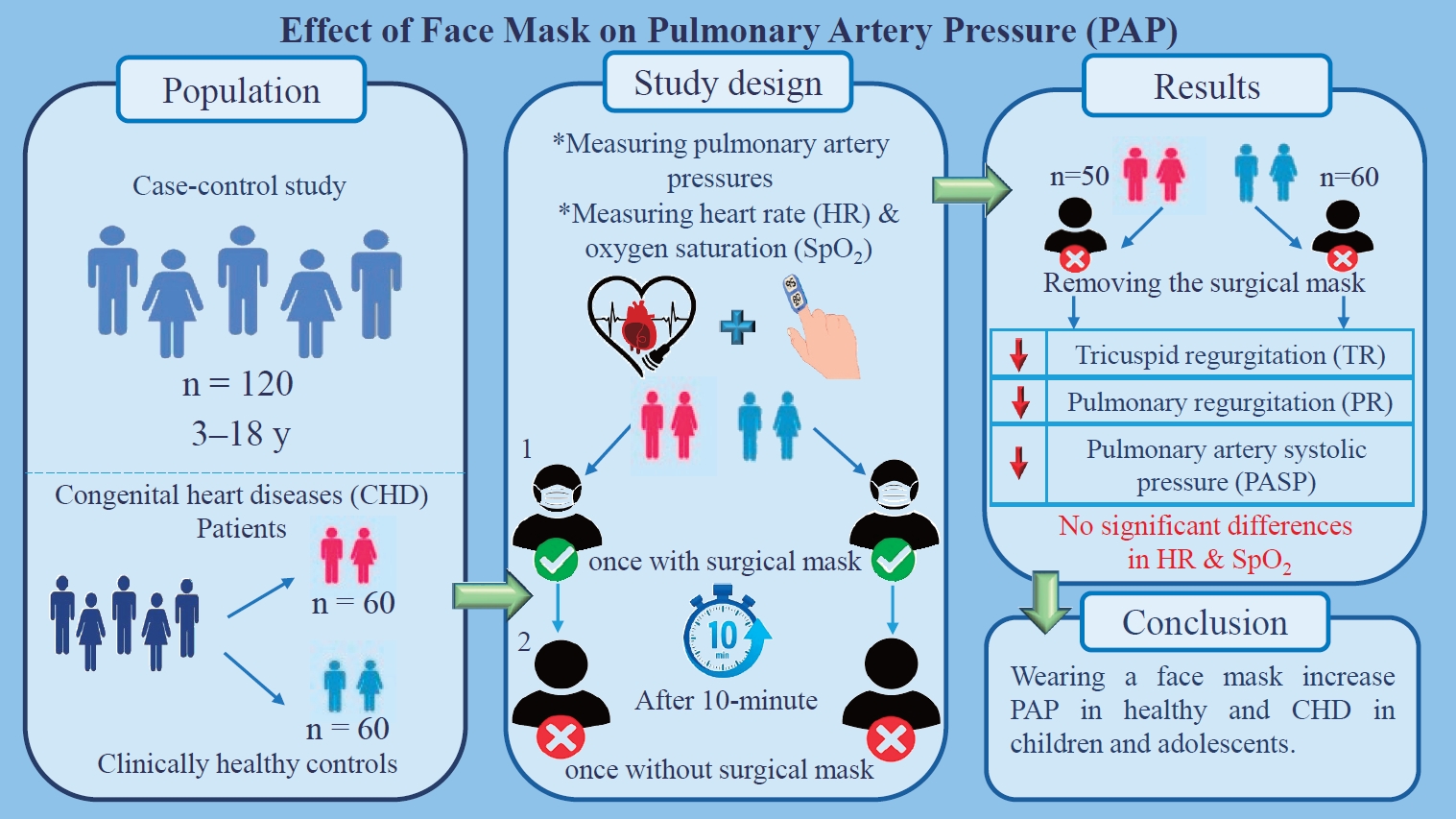
Question: Can face masks alter pulmonary pressure in children and adolescents with and without congenital heart disease?
Findings: Mask removal during echocardiography (ECHO) reduced pulmonary pressure.
Meaning: These findings suggest that face masks should be removed during ECHO in children and adolescents.
- Review Article
- Nutrition
- Macronutrients modified dietary intervention in the management of overweight/obese children and adolescents: a systematic review
- Jihyun Park, Oh Yoen Kim
- Clin Exp Pediatr. 2024;67(4):191-200. Published online July 11, 2023
-

· Dietary macronutrient modifications affect the body composition of and metabolic markers in children and adolescents.
· Hypocaloric diets, regardless of macronutrient composition, are reportedly effective for weight loss in obese children.
· Future interventional studies with meta-analyses that include Korean children and adolescents are needed to provide basic information applicable to this population.
- Original Article
- Gastroenterology
- Relationship between nonalcoholic fatty liver disease and hyperandrogenemia in adolescents with polycystic ovary syndrome
- Ozlem Kara, Hanife Aysegul Arsoy, Murat Keskin
- Clin Exp Pediatr. 2023;66(9):395-402. Published online June 14, 2023
-

Question: Is polycystic ovary syndrome (PCOS) a risk factor for nonalcoholic fatty liver disease (NAFLD) in adolescents?
Finding: The frequency of NAFLD did not increase in adolescents with PCOS. However, hyperandrogenemia was a risk factor for NAFLD.
Meaning: Adolescents with PCOS and hyperandrogenemia should be closely monitored for hepatic steatosis.
- Review Article
- Infection
- COVID-19 in immunocompromised children and adolescents
- Byung Ok Kwak, Byung Wook Eun
- Clin Exp Pediatr. 2023;66(5):182-189. Published online April 18, 2023
-

Most immunocompromised children and adolescents are not at increased risk of developing severe coronavirus disease 2019 (COVID-19). COVID-19 outcomes for low- or medium-risk immunocompromised children are favorable, while more serious illness reportedly occurs in high-risk immunocompromised children by underlying disease, its treatments, and other factors. Therefore, the early detection and timely management of severe COVID-19 and treatment of underlying disease are important. Hospitalization and COVID-19 vaccination should be carefully considered.
- Nutrition
- Total energy expenditure measured by doubly labeled water method in children and adolescents: a systematic review
- Nahyun Kim, Jonghoon Park
- Clin Exp Pediatr. 2023;66(2):54-65. Published online October 17, 2022
-

This systematic review summarizes convincing evidence that total energy expenditure (TEE) measured using the doubly labeled water technique increased with age from 1 to 18 years, while fat-free mass (FFM) increased with growth. TEE and in normal-weight participants, while physical activity level did not differ from that of normal-weight participants.
- Infection
- Therapeutics for the treatment of coronavirus disease 2019 in children and adolescents
- Soo-Han Choi, Jae Hong Choi, Ki Wook Yun
- Clin Exp Pediatr. 2022;65(8):377-386. Published online June 27, 2022
-
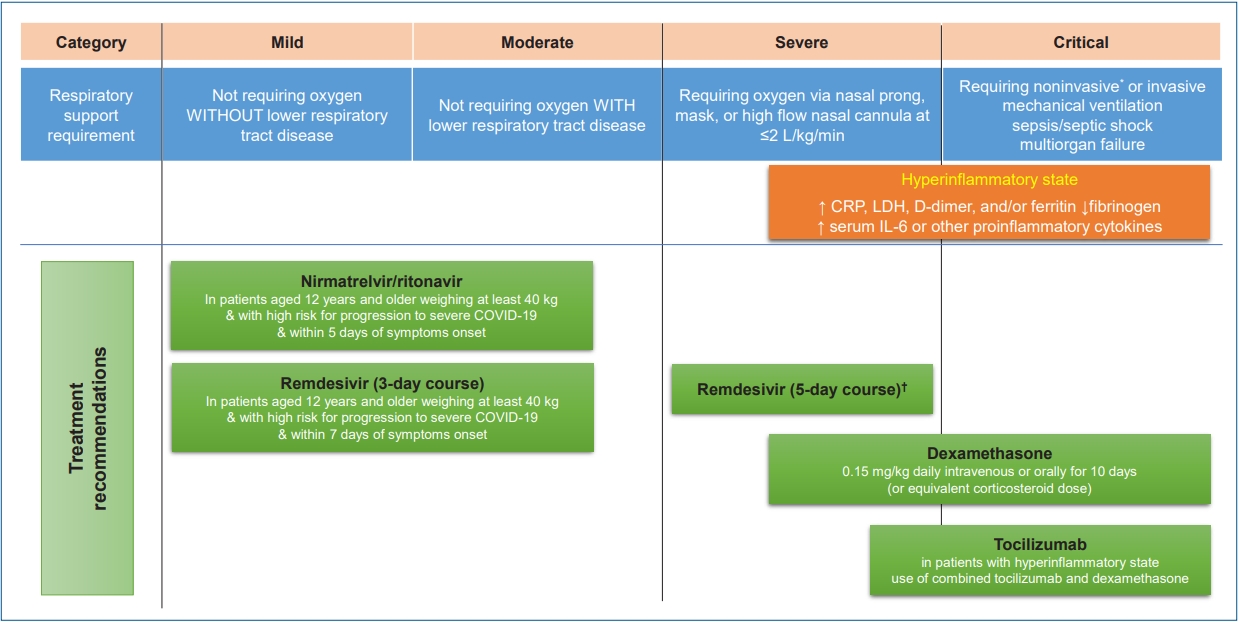
· Children and adolescents with high risks for severe coronavirus disease 2019 (COVID-19) should be identified and proper treatment should be provided promptly according to the patient’s condition.
· Remdesivir can be considered for pediatric patients of all ages with COVID-19 who have an emergent or increase in supplemental oxygen.
· The use of corticosteroids is not recommended for patients with nonsevere COVID-19. Corticosteroids are recommended in children and adolescents with severe and critical COVID-19.
- Original Article
- Developmental and Behavioral Medicine
- Effectiveness of obesity interventions among South Korean children and adolescents and importance of the type of intervention component: a meta-analysis
- Siyoung Choe, Jaesin Sa, Jean-Philippe Chaput, Deokjin Kim
- Clin Exp Pediatr. 2022;65(2):98-107. Published online November 23, 2021
-

Question: What is the overall effect of obesity interventions among Korean children and what affects their effectiveness?
Finding: Interventions were strongly favored over controls. Interventions including at least one physical activity component were significantly better than those that did not. Sex, age, baseline weight category, intervention duration, and the number of intervention components were not significant.
Meaning: Future obesity interventions for Korean children must seek to include physical activity components.
- Emergency Medicine
- Nonfatal injuries in Korean children and adolescents, 2007–2018
- Gyu Min Yeon, Yoo Rha Hong, Seom Gim Kong
- Clin Exp Pediatr. 2022;65(4):194-200. Published online September 9, 2021
-

Question: How many children and adolescents have experienced nonfatal injuries in the previous year?
Finding: Among Korean children and adolescents, 8.1% experienced at least one injury per year. We found no significant change in the incidence of injuries over the previous 12 years.
Meaning: The incidence of injuries is higher than this estimation; therefore, more attention and effort are needed to prevent injuries among children and adolescents.
- Review Article
- Endocrinology
- Endocrine comorbidities of pediatric obesity
- Jieun Lee, Jae Hyun Kim
- Clin Exp Pediatr. 2021;64(12):619-627. Published online August 26, 2021
-
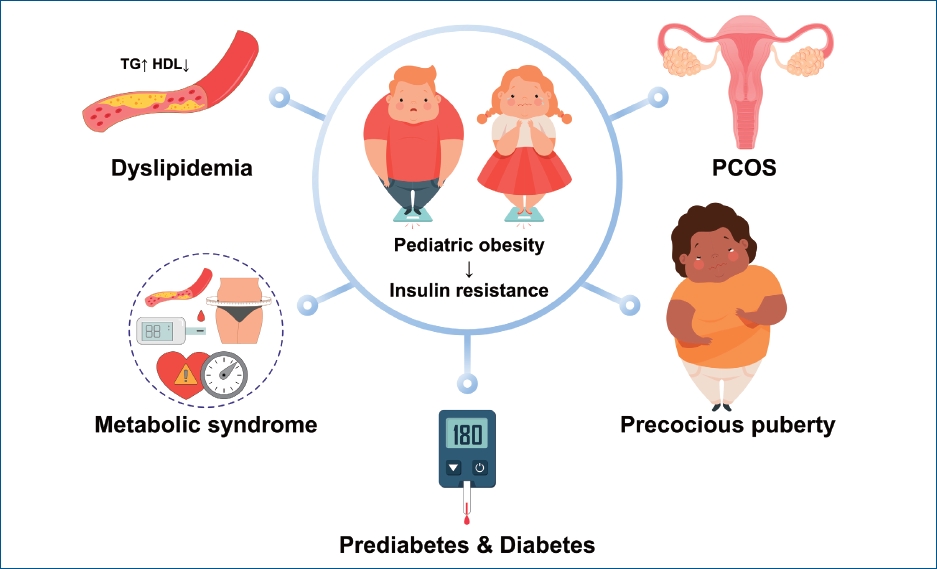
∙ Pediatric obesity can involve endocrine comorbidities such as prediabetes, type 2 diabetes, dyslipidemia, metabolic syndrome, polycystic ovary syndrome, and central precocious puberty.
∙ Prediabetes and type 2 diabetes in youth aged 10–19 years had a prevalence of 25.9% and 0.6% in 2013–2014, respectively.
∙ Dyslipidemia in Korean adolescents aged 10–18 years had a prevalence of 7.64% (total cholesterol ≥200 mg/dL), 6.09% (low-density lipoprotein cholesterol ≥130 mg/dL), 8.69% (triglyceride ≥150 mg/dL), and 12.52% (high-density lipoprotein cholesterol ≤40 mg/dL) in 2007–2018.
∙ Metabolic syndrome in Korean youth has a prevalence of 1.9%–14.7% in males and 1.7%–12.6% in females with wide variation in definitions.
∙ Appropriate comorbidity screening and management and/or specialist referral are necessary for obese children and adolescents.
- Nutrition
- Dietary intake and nutritional status of Korean children and adolescents: a review of national survey data
- Minji Kang, So Yoon Choi, Minyoung Jung
- Clin Exp Pediatr. 2021;64(9):443-458. Published online December 28, 2020
-
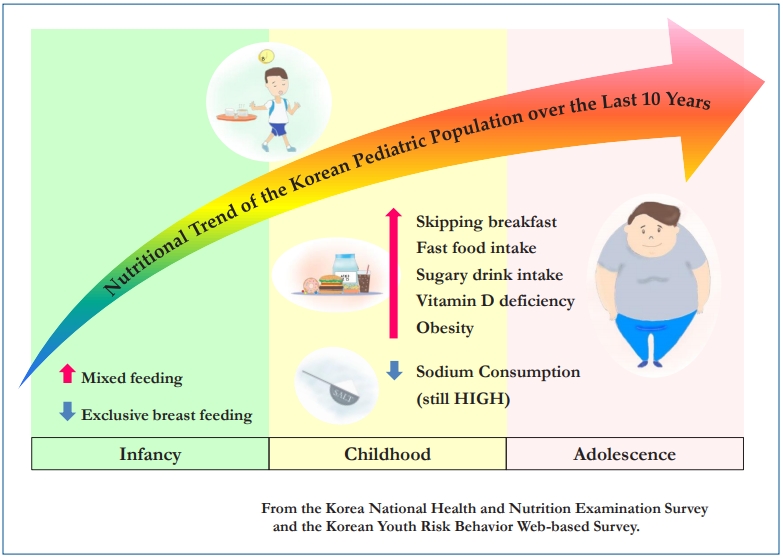
In Korea, several national cross-sectional surveys monitor the diet, nutritional status, and health status of children. This continual dedicated national surveillance system contributes to the identification of nutritional and health issues, establishment of public health policies, and development of nutrition recommendations. This paper provides recent information about the Korea National Health and Nutrition Examination Survey and the Korean Youth Risk...
- Guideline
- Endocrinology
- 2017 Clinical practice guidelines for dyslipidemia of Korean children and adolescents
- Jung Sub Lim, Eun Young Kim, Jae Hyun Kim, Jae-Ho Yoo, Kyung Hee Yi, Hyun Wook Chae, Jin-Ho Choi, Ji Young Kim, Il Tae Hwang; the Committee of Dyslipidemia of Korean Children and Adolescents on behalf of Korean Society of Pediatric Endocrinology (KSPE)
- Clin Exp Pediatr. 2020;63(12):454-462. Published online November 25, 2020
-

Question: How are children and adolescents with dyslipidemia treated and managed in Korea?
Finding: 2017 guidelines recommend to measure nonfasting non-HDL-C as a screening test and introduce new diet methods: Cardiovascular Health Integrated Lifestyle Diet (CHILD)-1, CHILD-2-low-density lipoprotein cholesterol, and CHILD-2-triglyceride. Statin is the only drug approved in children older than 10 years.
Meaning: New clinical practice guidelines for treating and managing dyslipidemia of Korean children and adolescents are provided.
- Original Article
- Hematology
- Changes in the prevalence of anemia in Korean adolescents, 1998–2018
- Jun Young An, Yoo Rha Hong, Seom Gim Kong
- Clin Exp Pediatr. 2021;64(2):86-92. Published online November 16, 2020
-

Question: Over the past 21 years, has the prevalence of anemia decreased among Korean adolescents?
Finding: The prevalence of anemia in boys aged 10–18 years decreased from 3.0% to 0.5% over the study period, whereas that in girls did not change significantly over time (increased from 7.9% to 8.5%).
Meaning: The prevalence of anemia in female adolescents remains high, requiring attention and efforts to improve it.
- Review Article
- Gastroenterology
- Changing prevalence of Helicobacter pylori infection in children and adolescents
- Ji Sook Park, Jin Su Jun, Ji-Hyun Seo, Hee-Shang Youn, Kwang-Ho Rhee
- Clin Exp Pediatr. 2021;64(1):21-25. Published online July 15, 2020
-
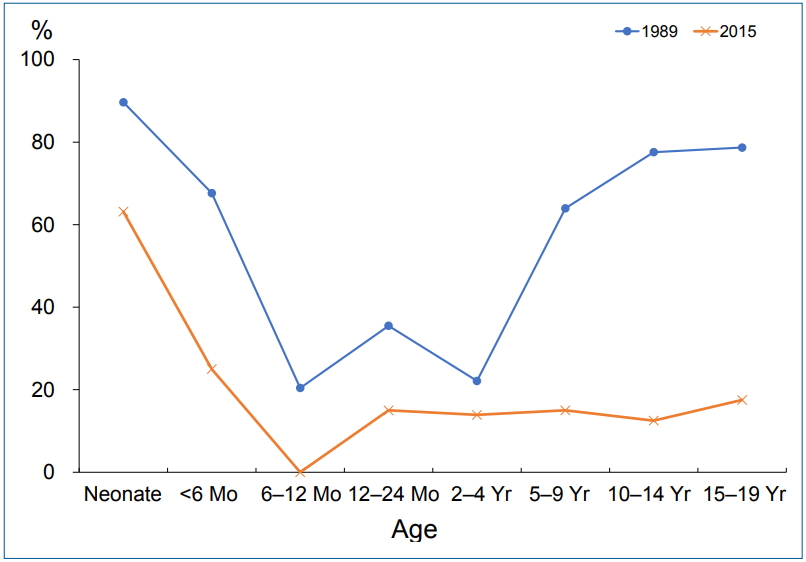
Although Helicobacter pylori infection rate in children is unclear due to diversity and limitation of diagnostic tests unlike in adults, investigation the childhood prevalence is important for predicting H. pylori-related diseases in the future.
H. pylori infection occurred in early childhood, and declined during 30 years in our study.
Change in risk factors of H. pylori transmission and consensus for eradication therapy in children might further reduce the infection rate.
- Recommended immunization schedule for children and adolescents: Committee on Infectious Diseases of the Korean Pediatric Society, 2018
- Eun Hwa Choi, Su Eun Park, Yae-Jean Kim, Dae Sun Jo, Yun-Kyung Kim, Byung-Wook Eun, Taek-Jin Lee, Jina Lee, Hyunju Lee, Ki Hwan Kim, Hye-Kyung Cho, Eun Young Cho, Jong-Hyun Kim
- Clin Exp Pediatr. 2019;62(7):252-256. Published online July 15, 2019
-
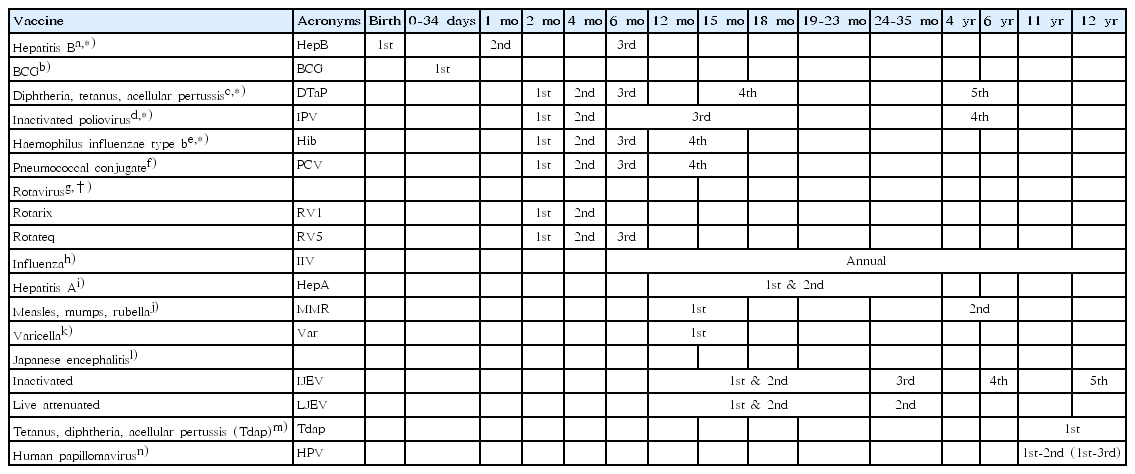
The Committee on Infectious Diseases of the Korean Pediatric Society recommended immunization schedule for children and adolescents aged 18 years or younger in the 9th (2018) edition of Immunization guideline. This report provides the revised recommendations made by the committee and summarizes several changes from the 2015 guideline. National immunization program (NIP) launched a human papillomavirus (HPV) immunization for girls...
- Original Article
- General Pediatrics
- Prevalence of hyperuricemia and its association with metabolic syndrome and cardiometabolic risk factors in Korean children and adolescents: analysis based on the 2016–2017 Korea National Health and Nutrition Examination Survey
- Jung Hyun Lee
- Clin Exp Pediatr. 2019;62(8):317-323. Published online June 24, 2019
-
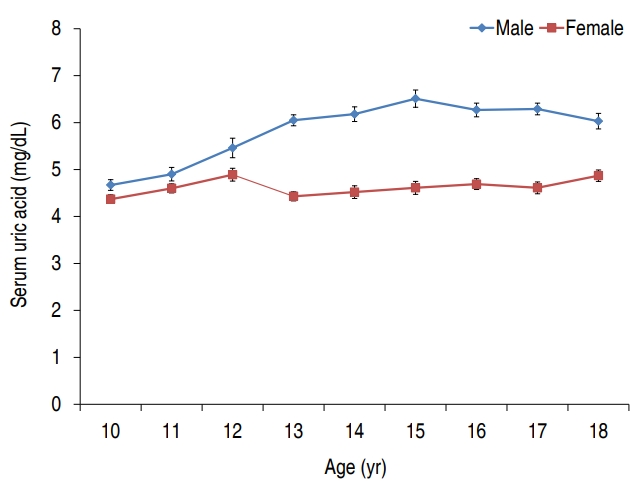
Purpose: Investigating the prevalence of hyperuricemia and its association with metabolic syndrome (MetS) and cardiometabolic risk factors (CMRFs) in Korean children and adolescents. Methods: This cross-sectional survey used data from the 7th Korea National Health and Nutrition Examination Survey (2016–2017); 1,256 males and females aged 10–18 years were included. Hyperuricemia was defined as serum uric acid levels were >6.6 mg/dL at...
- Endocrinology
- Prevalence and associates of obesity and overweight among school-age children in a rural community of Thailand
- Teechaya Nonboonyawat, Wuttipat Pusanasuwannasri, Nattanon Chanrat, Natta Wongthanavimok, Danutanut Tubngern, Piengkwan Panutrakul, Mathirut Mungthin, Thirapa Nivesvivat, Panadda Hatthachote, Ram Rangsin, Phunlerd Piyaraj
- Clin Exp Pediatr. 2019;62(5):179-186. Published online February 8, 2019
-
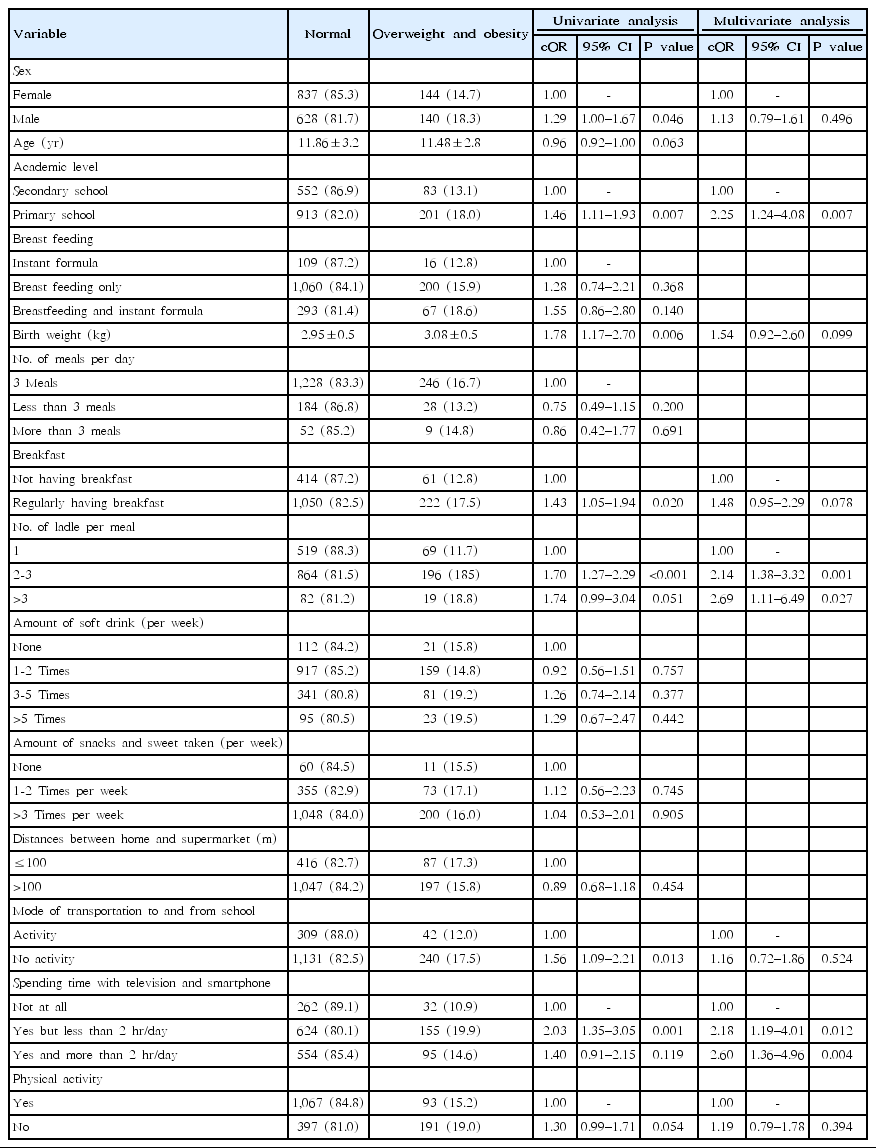
Purpose: Information about overweight and obesity among students in rural areas of Thailand is limited. Therefore, we aimed to determine overweight and obesity prevalences and associated factors among school-aged children in a rural community of Thailand. Methods: We selected 9 public schools through cluster sampling in 2 provinces located in central Thailand in 2016. Anthropometric measurements were measured using standard techniques,...
- Secular change in waist circumference and waist-height ratio and optimal cutoff of waist-height ratio for abdominal obesity among Korean children and adolescents over 10 years
- Min Sub Kim, Se Young Kim, Jae Hyun Kim
- Clin Exp Pediatr. 2019;62(7):261-268. Published online December 3, 2018
-

Purpose: This study aimed to evaluate the time trends of waist circumference (WC) and waist-height ratio (WHR), and to present WC and WHR distributions with optimal WHR cutoff for abdominal obesity in Korean children and adolescents. Methods: We performed a retrospective cross-sectional analysis of data from 13,257 children and adolescents (6,987 boys and 6,270 girls) aged 6–18 years who were included...
- Adolescence Medicine
- Serum alanine aminotransferase levels are closely associated with metabolic disturbances in apparently healthy young adolescents independent of obesity
- Ki Eun Kim, Kyung Suk Baek, Sol Han, Jung Hyun Kim, Youn Ho Shin
- Clin Exp Pediatr. 2019;62(2):48-54. Published online November 23, 2018
-

Purpose: Liver metabolism plays a pivotal role in the development of metabolic disorders. We aimed to investigate the clinical and laboratory risk factors associated with alanine aminotransferase (ALT) levels in young adolescents from an urban population in Korea. Methods: A population of 120 apparently healthy adolescents aged 12–13 years was included in the cross-sectional design study; 58 were overweight or obese...
- Nephrology (Genitourinary)
- Renal involvement in children and adolescents with inflammatory bowel disease
- Hea Min Jang, Hee Sun Baek, Jung-Eun Kim, Ju Young Kim, Yeon Hee Lee, Hee Yeon Cho, Yon Ho Choe, Ben Kang, Byung-Ho Choe, Bong Seok Choi, Min Hyun Cho
- Clin Exp Pediatr. 2018;61(10):327-331. Published online September 12, 2018
-

Purpose: The incidence of inflammatory bowel disease (IBD) is rapidly increasing, and several reports have described the renal complications of IBD. We sought to evaluate the clinical manifestations of renal complications in children with IBD in order to enable early detection and prompt treatment of the complications. Methods: We retrospectively reviewed the medical records of 456 children and adolescents aged <20...
- Review Article
- General Pediatrics
- The 2017 Korean National Growth Charts for children and adolescents: development, improvement, and prospects
- Jae Hyun Kim, Sungha Yun, Seung-sik Hwang, Jung Ok Shim, Hyun Wook Chae, Yeoun Joo Lee, Ji Hyuk Lee, Soon Chul Kim, Dohee Lim, Sei Won Yang, Kyungwon Oh, Jin Soo Moon; for the Committee for the Development of Growth Standards for Korean Children and Adolescents, the Committee for School Health and Public Health Statistics; the Committee for School Health and Public Health Statistics; the Korean Pediatric Society, and Division of Health and Nutrition Survey; Korea Centers for Disease Control and Prevention
- Clin Exp Pediatr. 2018;61(5):135-149. Published online May 28, 2018
-

Growth charts are curves or tables that facilitate the visualization of anthropometric parameters, and are widely used as an important indicator when evaluating the growth status of children and adolescents. The latest version of the Korean National Growth Charts released in 2007 has raised concerns regarding the inclusion of data from both breastfed and formula-fed infants, higher body mass index...
- Original Article
- Endocrinology
- The association of total blood mercury levels and overweight among Korean adolescents: analysis of the Korean National Health and Nutrition Examination Survey (KNHANES) 2010–2013
- Yi-Yeon Shin, In-Kyung Ryu, Mi-Jung Park, Shin-Hye Kim
- Clin Exp Pediatr. 2018;61(4):121-128. Published online April 23, 2018
-
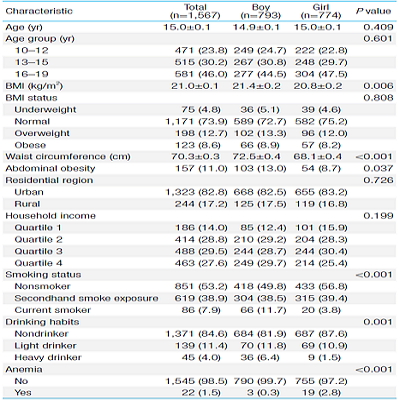
Purpose Obesity has been associated with higher total blood mercury levels, based on animal studies; however, studies that focus on children and adolescents are lacking. We aimed to assess the association between total blood mercury levels and the incidence of overweight and abdominal obesity in Korean adolescents.
Methods The study population comprised 1,567 adolescents (793 boys and 774 girls; aged 10–19 years), who...
-

-
-
8.02023CiteScore94th percentilePowered by
-
Impact Factor3.2
-
- TOPICS
- ARTICLE CATEGORY
- Editorial Office
-
Korean Pediatric Society
#1606 Seocho World Officetel, 19 Seoun-ro, Seocho-ku, Seoul 06732, Korea
Tel: +82-2-3473-7306 Fax: +82-2-3473-7307 E-mail: office@e-cep.org
Clinical and Experimental Pediatrics is an open access journal. All articles are distributed under the terms of the Creative Commons Attribution NonCommercial License (http://creativecommons.org/licenses/by-nc/4.0/)
Copyright © 2025 by Korean Pediatric Society.











